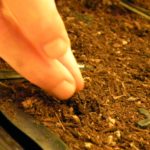Digging in the Dirt
The January meeting found Mission Hills Garden Club’s members plus a few grandchildren learning about planting seeds. Fausto Palafox, our president and owner of Mission Hills Nursery, gave us the basics about seeds and how to grow them because starting with seeds is far cheaper and you have more selection than starting with baby plants.
Seeds are embryonic plants. Inside their protective coats is nearly everything they need to grow into a plant: each seed contains the DNA of its parents and usually some nutrients. To thrive seeds need water, light (or its absence) and the proper temperature. You have more control over the seeds’ environment by starting them indoors.
First you will need a container. Anything with holes for drainage is fine so long as the containers have been cleaned. One part bleach to nine parts water makes a good soaking solution in which to sanitize them. Choose your container according to the size the seed, the size that plant will be at transplanting, and how they will be planted: as individually or in clumps.
The soil is even more important than the container. Fausto says, “You get what you pay for.” He means that the mixture you give your seeds should be designed for that purpose. Outside soil is not a good choice as many organisms when removed from their natural environment can weaken or kill your seeds and seedlings. You need a soil designed to foster proper moisture and nutrients (usually made from finely ground peat moss and something like vermiculite) for your babies.
Light is essential as well as soil. Light (or its absence) informs the seeds when to germinate. They depend on the proper strength and duration of light. Large seeds will not germinate in light and must be planted more deeply than small seeds which grow. Most small seeds prefer 14 hours or more of light each day.
The proper temperature is also important for the development of a healthy plant. Cold temperatures may hinder or slow germination; higher temperatures (70 degrees or above) foster growth in most plants. You may want to provide artificial light and/or heat with florescent lighting and placing containers near a heat source. You may also use special heating pads placed under the containers. Your nursery will offer suggestions.
Like humans, plants’ largest component is water. A seed absorbs water when it comes into contact with it. Too much water will cause it to rot. Too little may result in drying to the point of death or of weakening the sprout. With small seeds shallowly sown, Fausto recommends misting the soil often to maintain even moisture. Fausto also advocates covering the container with a clear plastic cover or even plastic wrap to help keep moisture even. In addition, He mentioned that seed packets come with directions and suggestions. They were written by the people who are specialists in their final product. When all else fails, read the directions. Finally, don’t forget to label each container so you know what you planted.
Thanks to Fausto and Toni, we received containers, soil and two categories of seeds – ornamental and edible. Each of us received a flat with six pony packs filled with top quality organic soil. With a dibble (a pointed object such as a pen, pencil, chopstick, or skewer) we made an indentation in each section of our pony packs. We gently poured three to six seeds in each and gently tapped the soil over them. Next we misted them with water. Our homework is to keep our soil damp by misting as needed. When the plants’ roots are visible beneath the pony packs, it will be time for us to plant our seedlings in their permanent homes.
At the March meeting, Carey Worthy will discuss Feng Shui for your garden. Meetings are from 6 until 8 p. at the church at 4070 Jackdaw. Members are free; guest fee is $10 which you may apply toward your membership if you join that night.
Don’t forget the Garden Walk on May 11, from 10 until 4. We need volunteers. You need not be a Garden Club member to help with many of the jobs.
Category: Local News








